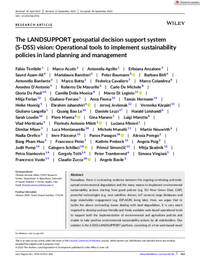The LANDSUPPORT geospatial decision support system (S-DSS) vision: Operational tools to implement sustainability policies in land planning and management

Authors:
Nowadays, there is contrasting evidence between the ongoing continuing and widespread environmental degradation and the many means to implement environmental sustainability actions starting from good policies (e.g. EU New Green Deal, CAP), powerful technologies (e.g. new satellites, drones, IoT sensors), large databases and large stakeholder engagement (e.g. EIP-AGRI, living labs). Here, we argue that to tackle the above contrasting issues dealing with land degradation, it is very much required to develop and use friendly and freely available web-based operational tools to support both the implementation of environmental and agriculture policies and enable to take positive environmental sustainability actions by all stakeholders. Our solution is the S-DSS LANDSUPPORT platform, consisting of a free web-based smart Geospatial CyberInfrastructure containing 15 macro-tools (and more than 100 elementary tools), co-designed with different types of stakeholders and their different needs, dealing with sustainability in agriculture, forestry and spatial planning. LANDSUPPORT condenses many features into one system, the main ones of which were (i) Web-GIS facilities, connection with (ii) satellite data, (iii) Earth Critical Zone data and (iv) climate datasets including climate change and weather forecast data, (v) data cube technology enabling us to read/write when dealing with very large datasets (e.g. daily climatic data obtained in real time for any region in Europe), (vi) a large set of static and dynamic modelling engines (e.g. crop growth, water balance, rural integrity, etc.) allowing uncertainty analysis and what if modelling and (vii) HPC (both CPU and GPU) to run simulation modelling ‘on-the-fly’ in real time. Two case studies (a third case is reported in the Supplementary materials), with their results and stats, covering different regions and spatial extents and using three distinct operational tools all connected to lower land degradation processes (Crop growth, Machine Learning Forest Simulator and GeOC), are featured in this paper to highlight the platform's functioning. Landsupport is used by a large community of stakeholders and will remain operational, open and free long after the project ends. This position is rooted in the evidence showing that we need to leave these tools as open as possible and engage as much as possible with a large community of users to protect soils and land.
